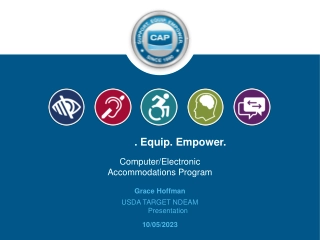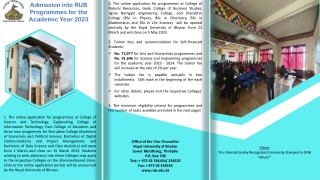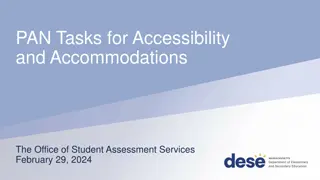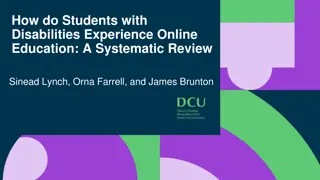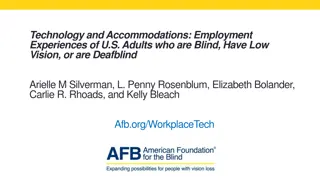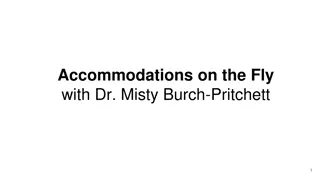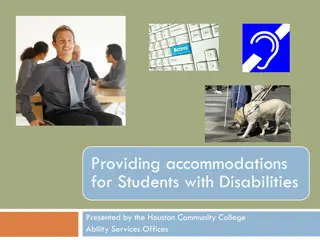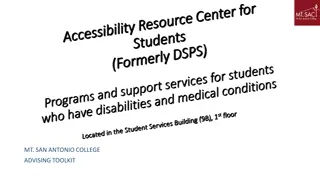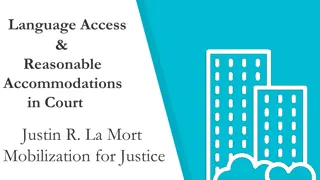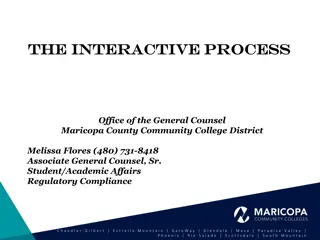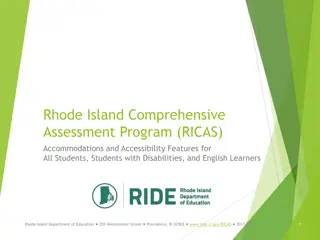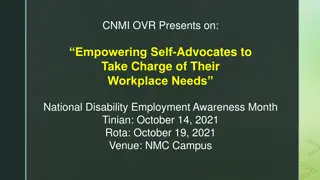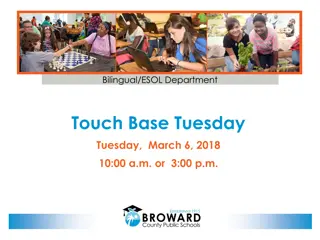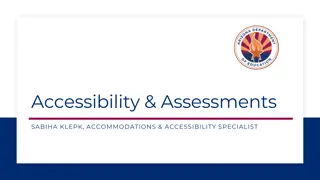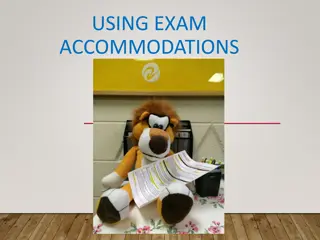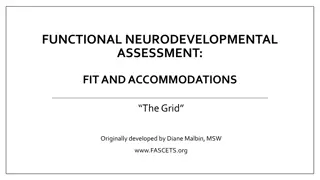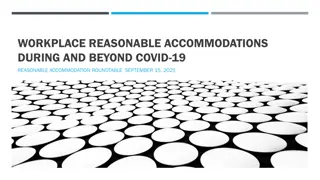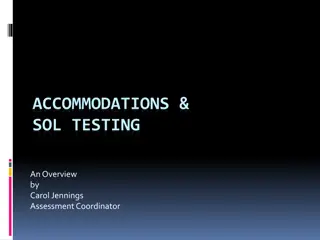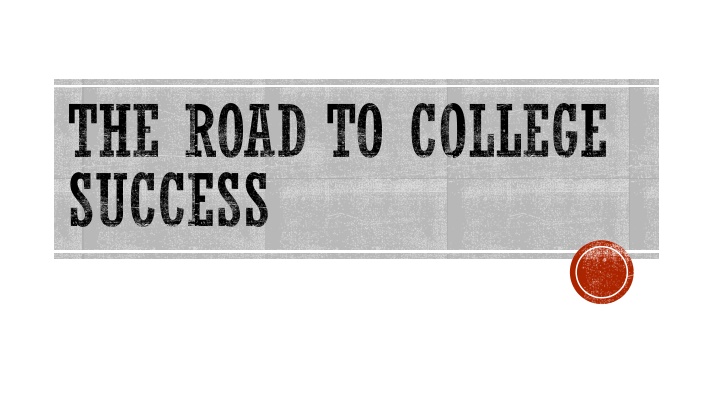
the ADA: Ensuring College Success for Students with Disabilities
Learn about the rights and responsibilities of college students with disabilities under the ADA. Discover how colleges accommodate students with various impairments and the importance of advocacy for a successful academic journey.
Download Presentation

Please find below an Image/Link to download the presentation.
The content on the website is provided AS IS for your information and personal use only. It may not be sold, licensed, or shared on other websites without obtaining consent from the author. If you encounter any issues during the download, it is possible that the publisher has removed the file from their server.
You are allowed to download the files provided on this website for personal or commercial use, subject to the condition that they are used lawfully. All files are the property of their respective owners.
The content on the website is provided AS IS for your information and personal use only. It may not be sold, licensed, or shared on other websites without obtaining consent from the author.
E N D
Presentation Transcript
THE ROAD TO COLLEGE SUCCESS
INTRODUCTIONS Emily Robinson From Poca, West Virginia WVSU Student & WVSILC member Molly Spence From Hurricane, West Virginia Writer & WVSILC member
STATISTICS About 11% of undergraduates, or over 2 million students, have a disability. Most have disabilities like dyslexia or attention deficit hyperactivity disorder 15% have an orthopedic or mobility impairment; 6% have a hearing impairment; 3% are blind or visually impaired In college, it is the responsibility of the students to identify themselves and request services. Colleges that accept a physically disabled student must at least make essential spaces like the library, residence hall, lab, and classrooms-accessible. Once the college has determined appropriate accommodation arrangements, professors cannot refuse to comply with them. The purpose of accommodation is to level the playing field for students with disabilities When they leave college to go out into the real world, they must advocate for themselves
ADA (AMERICANS WITH DISABILITIES ACT) The ADA prohibits discrimination on the basis of disability in employment, state and local government, public accommodations, commercial facilities, transportation, and telecommunication. The ADA protects one with a disability or a person who has a relationship or association with an individual that has a disability. An individual with a disability is defined by the ADA as a person who has a physical or mental impairment that substantially limits one or more major life activities. The ADA DOES NOT specifically name all all of the impairments that are covered.
ADA TITLE II: PUBLIC ACCOMMODATIONS Title II of the ADA prohibits ALL states and local governmental entities, including public colleges and universities, from discriminating against people with disabilities. May not refuse to allow a person with a disability to participate in a service, program, or activity, simply because the person has a disability. Must provide programs and services in an integrated setting, unless separate or different measures are necessary to ensure equal opportunity. Under Title II a person with a disability is defined as a person who has a physical or mental impairment that substantially limits "major life activities", or has a record as such an impairment, or is regarded as having such an impairment. Physical barriers that keep an individual with a disability from participating in a program or service is in direct violation of ADA Title II.
ADA TITLE III Places of public accommodations include over 5 million private establishments from retail stores to zoos. Public accommodations must provide goods and services in integrated settings unless separate or different measures are necessary to ensure equal opportunity. Furnish auxiliary aids when necessary to ensure effective communication unless it causes undue burdens as a result. Places must remove any architectural and structural communication barrier in existing facilities.
SECTION 504 Section 504 states that "no qualified individual with a disability in the United States shall be excluded from, denied benefits of, or be subjected to discrimination under" any program or activity that either receives Federal financial assistance or is conducted by any executive agency. Section 504 covers any college or university that receives direct or indirect federal financial assistance, including those that accept students who receive federal financial aid Section 504 may be enforced through private lawsuits. It is not necessary to file a complaint with a federal agency or to receive a "right-to-sue" letter before going to court. If an impairment lasts 6 months or shorter, it does not meet Section 504's definition.
EXAMPLES OF DISCRIMINATORY ACTION Denying a qualified individual with a disability admission because of his/her disability. Excluding a qualified student with a disability "from any course, course of study, or other part of its education program or activity" because of his/her disability Counseling a qualified student with the disability towards a more restrictive career objectives than other students.
WHAT ARE REASONABLE ACCOMMODATIONS? Reasonable accommodations are modifications or adjustments to the task, environment, or to the way things are usually done that enable individuals with disabilities to have an equal opportunity to participate in academic program or a job.
SAMPLE ACCOMMODATIONS Disability Type Low vision Accommodation Type Sitting near the front of the class,Large print materials,Contrast- enhanced materials,Electronic Format of materials,Glare guards, Supplementary light source Blindness Audio-recorded, Braille or electronic-formatted notes and text, Verbal or audio description of visuals and videos, raised line drawings and tactile models, Adaptive lab equipment, computer reader, speech output. Hearing Loss Sign language interpreter, front seating, FM system, notetaker, alternate location for testing, written assignment.
SAMPLE ACCOMMODATIONS (CONTINUED) Disability Type Learning Disability Accommodation Type Notetaker, audio recorded lectures, captioned films, extended times on exams and assignments, alternative testing area, instructions provided in multiple formats, computer assistance, concise oral and written instructructions Notetaker, classrooms, labs, and field trips in accessible locations, computer with speech input, wheelchair-friendly furniture in room arrangement, use of ramps and raised platforms, class materials available in electronic format, extended time for completion of activities Alternative assignments for oral presentations, flexibility with in class discussions, course substitutions Notetakers, flexible attendance requirement, extra time and allowances for breaks, assignments made available in electronic format, use of email to facilitate communication. Mobility/ Motor Impairment Speech Impairment Chronic Health Condition
HOW DO I GET ACCOMMODATIONS? Step 1: Contact your school's disability services office or ADA coordinator. Step 2: Not sure of what accommodations you need? Seek assistance from your school's disability services office and your medical professionals. Vocational rehabilitation can help as well. Step 3: Make a request of accommodations in writing. The request should include the student name, disability, and how the disability can affect your participation in school, and identify specific accommodations that you need. With the request, include documentation. Primary documentation: self report or self request Secondary documentation: observation and interaction, intake interview Tertiary documentation: information from external or a third party
KEY DIFFERENCES High School IDEA: entitled to services through a Free & Appropriate Public Education. Students have access to general & special education classes through an IEP. Areas Legal Protection College ADA & Rehab Act: must be eligible for services. IEP IEPs are not used in college. Classes include students with & without disabilities. The curriculum is not modified. Students must provide the college with current documentation of a disability as his/her expense. Student's IEP may be used as supplemental information but other information is typically required. Disability Documentation The school district is responsible for identifying and evaluating students with disabilities.
KEY DIFFERENCES (CONTINUED) Areas Receiving Accommodations High School The IEP process identifies students accommodations. College Student must initiate the process & register with the Disability Support Services office on campus. Student advocates for accommodations & services. Students are protected under the Family Educational Rights and Privacy Act. Parents do not communicate with professors or have access to grades and student information. Advocating Teacher, parents, & students advocate for services. Parents can see student records are notified and must sign permission for any changes or decisions for the students. Parent's Role
CAN A COLLEGE OR UNIVERSITY REFUSE TO PROVIDE AN ACCOMMODATION? Yes, but under limited circumstances. The ADA and Section 504 requires schools to provide accommodations that are reasonable. Your school should not refuse to provide an accommodation unless: A) providing the accommodation would create an undue financial or administrative burden for the school; B) providing the accommodation would fundamentally alter the school's academic program; C) The requested accommodation is of a personal nature.
WHAT TO DO IF A SCHOOL REFUSES TO GIVE ACCOMMODATION THAT IS NEEDED OR OTHERWISE DISCRIMINATES BECAUSE OF A DISABILITY File an internal grievance/appeal with the school; File a complaint with the Office of Civil Rights of the US Department of Education or the US Department of Justice. Try to resolve things informally through a private mediation; and/or File a lawsuit
HELPFUL TIPS TO REMEMBER...
THE SYLLABUS IS YOUR FRIEND! The syllabus is a contract or agreement between you and your professor. It is your professor s contact sheet. Contains the semester agenda. Gives a preview of the semester. Considered a vital resource of guidance. Lists disability service options and who to contact if they are needed.
PAY ATTENTION & TAKE NOTES Prepare: Be sure to complete reading assignments BEFORE you come to class! Not reading the chapters will cause you to be lost during discussion! Arrive Early: Arrive early and take a seat close to the board and slides in order to hear the lecture clearly. Attend: Not attending class is a big NO! You can t rely on classmates or online materials to keep you afloat. Less Words are More: Don t write down all of what you hear. Stick to only key information. Listen for Key Words & Phrases: Signal words can help you determine what is key (for example, listen for words like There are 3 reasons why , or And most important Review: Review your notes as quickly as possible after class while the material is still new in your mind. Revision: Spend time touching up on your notes and asking questions you may have.
HOW TO STUDY! (YES, YOU HAVE TO STUDY ) Where: Study area needs to be available when needed. Should be a distraction free zone. Your area should be a large area that gives you room to spread out all the materials you need. You should have enough light and a comfortable chair. When Make a routine schedule that includes studying. Choose study times and days when you are more likely to feel energetic. Use daylight hours. (Research shows that an hour of study time during the day is equal to 90 minutes of study at night. Plan to study in hour intervals. Determine how long you need to study to fully grasp a subject.
STUDY STRATEGIES Use behavior modification on yourself: Study the same subject at the same time at the same place. After awhile, you will find you start to get into learning that subject when you go to that certain spot. Don t spend more than 1 hour on a subject: Research has shown that more is learned in 1 hour sessions in 4 days than one marathon in 6 hours. Stay alert by taking breaks: Take a 10 minute break in between studying subjects. Study similar subjects at separate times: Mix up the subjects you are studying so you don t get similar material confused. Avoid studying when you are sleepy: You tend to retain less information when you are tired.
READING EFFECTIVELY Read the Introduction & The Summary: This gives you an idea of what you will cover in a particular chapter. Ask questions: Do it while you read and try to answer as you go through the chapter. Look for Visual Clues: Bold print, underlining, bullets, font size, and color can be used to draw attention to key concepts. Recall and Recite: After reading, ask yourself questions you created. Review: Review the introduction and the summary.
WAYS TO MANAGE YOUR TIME Keep yourself organized by writing down all of your weekly tasks in a day planner. Plan your routine before the start of each week. Prioritize yourself: Work first play later! Learn to say No to fun if you haven t completed what s needed to be done first. (Reinforcing the aforementioned statement) Don t wait until the last minute to do assigments. Make time for fun to avoid burnout.
WHAT CAN CAUSE ANXIETY? Three top sources of anxiety are: Social anxiety: Due to meeting new people and being in a new environment. Test Anxiety: Due to fear of not doing well on exams. Completely normal and very common! Course Overload: Taking on too many classes at one time. Start out slow.
Coping with Stress & Anxiety Don t be afraid to ask for help! Don t overload yourself! Pray, meditate, or do whatever you can to relax. Get plenty of sleep and eat regularly FIGHT OR FLIGHT RESPONSE a threatening situation, which readies one either to resist forcibly or to run away.
SOME EFFECTS OF STRESS Headaches Sleep Problems Anxiety Lack of Motivation Depression Change in Eating Habits Irritability Anger
HOW TO PREP FOR A TEST: MYTH VS. REALITY Myths Reality No question is a trick question. If there is more evidence that a question is confusing, it could be removed from future tests. There are no rules to about answer choices. Every question is written to test a specific skill or piece of knowledge. Tests are designed so that there will be PLENTY of time to answer every question. All questions are usually of equal point value. No questions are biased. The first question is always a trick question. The same answer choice never appears more than 3 times in a row. The questions aren t written to see what exactly you know; more to see how well you take standardized tests. Tests are designed so you have to answer questions quickly. Hard questions are worth more than easy questions Tests are full of biased questions.
THINGS TO REMEMBER READ YOUR SYLLABUS IT IS YOUR FRIEND! GO TO CLASS AND PAY ATTENTION! STUDY, STUDY, STUDY! MANAGE TIME WISELY! RELAX, BREATHE YOU CAN DO THIS!

